It's been called 'Bangkok's Brooklyn' -- an area west of the Chao Phraya River where artsy youth hang loose with grannies and grampas in century-old houses. Unlike swiftly transforming central Bangkok, most of the neighbourhoods perched along Thonburi's canals and alleyways haven't changed much over the past century. Foreign tourists are still a novelty, but those willing to stray from Bangkok's comfort zones are rightly rewarded.
Although it's not known exactly where the name came from (some say it derives from Bang Ko, or 'village of plums'), the original 'Bangkok" village was situated in what's now the Bangkok Yai and Bangkok Noi parts of Thonburi, making these the city's first areas to be settled. In those days, the Chao Phraya River flowed in a horseshoe shaped path to the west before cutting north towards Ayutthaya.
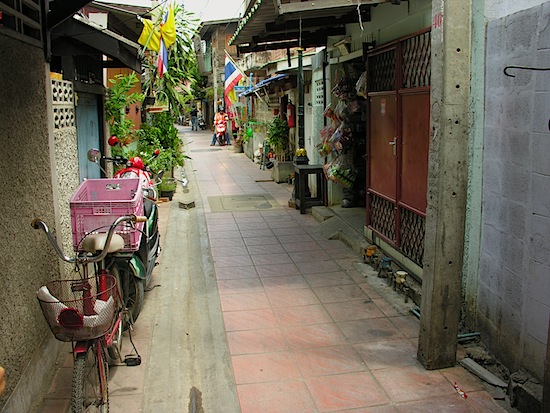
Heading into a typical Thonburi neighbourhood.
In the 1500s, a south-to-north running canal was dug to shorten the journey by boat from the Gulf of Thailand up to Ayutthaya. Over time, the strength of the current overtook this canal, effectively altering the Chao Phraya's path. The river's original horseshoe is now known as Bangkok Noi and Bangkok Yai khlongs, or canals. Temples and villages along these watery avenues, many of which still stand today, continued to serve as 'Bangkok" for another 200 years. Only when King Narai ordered the Vichaiprasit Fort to be built along the Chao Phraya's western bank in 1665 did the area become known as Thonburi, or 'Fortified City'. Parts of the old fort still stand today.
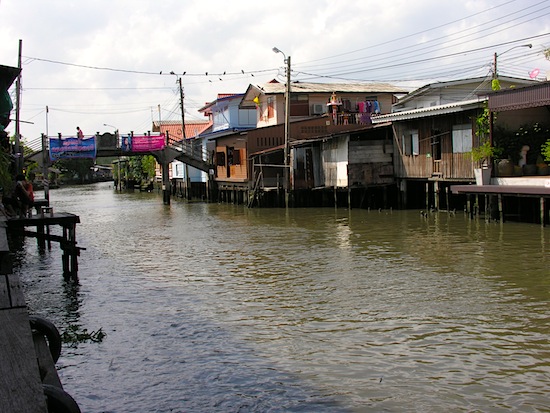
Bangkok Yai Canal -- ancestor of the Chao Phraya.
After the fall of Ayutthaya in 1767, the warrior-turned-king Taksin established his new palace and capital close to Vichaiprasit Fort, and for a brief stint Thonburi served as the capital of the Siamese Empire. Though the grounds of his palace and the fort are now home to Thai naval headquarters, a monument to Taksin stands imposingly today at Wongwian Yai roundabout in the heart of Thonburi. One of Bangkok's busiest bridges, Saphan Taksin, was also named after the former king (not a certain former prime minister in exile).
Wat Arun became Taksin's royal palace, and today its soaring ceramic spires remain Thonburi's only large-scale tourist attraction. It's the only slice of Thonburi ever seen by most visitors to Bangkok, but some great food, a unique coffee shop/art studio and the west side's laid back atmosphere can all be experienced in the neighbourhood behind Wat Arun.
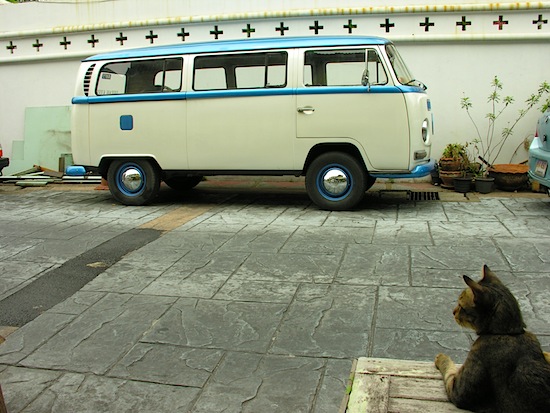
Chillin' behind Wat Arun.
A half kilometre south from Wat Arun brings you to Wat Kalayanamit, a bustling, ornate temple with considerable influence from the many Chinese immigrants who settled here. A short walk further south leads you past Ton Son Mosque -- one of the city's oldest -- and then on to Santa Cruz Church, a relic of Thailand's first European settlers. While at Santa Cruz, don't miss a distinctive Portuguese-Chinese-Thai snack that reflects the area's distinct cultural makeup.
Hundreds of years ago, Islam, Christianity and Buddhism (not to mention Taoism, Confuciunism and to some degree, Hinduism) were all practised in this single square kilometre of Thonburi. Apart from a few tourists, tuk tuks and modern buildings, little has changed today. If temples are your thing, Thonburi has plenty more, and most are historic but rarely visited by foreigners. Wat Pak Nam and Wat Kampaeng are two very different examples, each particularly special in its own way.
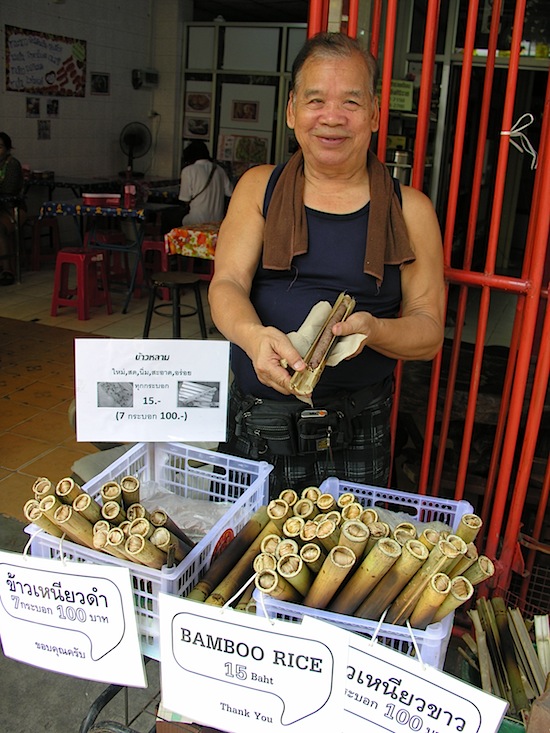
Friendly khao thom vendor in Wang Lang Market.
If you have the time to explore deeper into Thonburi, a good way to start is to take the Chao Phraya express boat to Wang Lang Market, one of the finest places in Bangkok to sample street food. While here, you might also go vintage clothes shopping, or head due west to pungent and colourful Bangkok Noi and Phran Nok wet markets.
If you're free on a Saturday or Sunday, make your way to Khlong Lat Mayom or Taling Chan floating markets.
On any day, head west and/or south from Wang Lang Market to check out a range of out-of-the-way cultural sites. Within striking distance is the Royal Barges Museum, worth a passing glance en route to sampling adorable Thai sweets at Baan Luk Chup. Cross back over Bangkok Noi Canal and you're not far from the bronze-smiths of Baan Bu. After watching traditional bronze bowls torched and polished by hand, stop by Bangkok Noi Museum to learn about Thonburi's past.
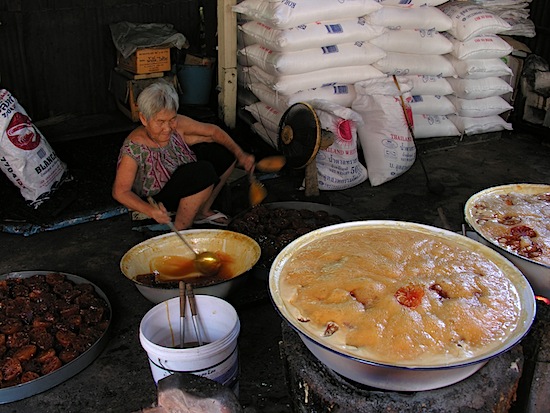
Boiling the bael fruit at Soi Mathum.
Further west, get your creative juices flowing at Khlong Bang Luang artist village, so called due to it sitting along a stretch of Bangkok Yai canal that was once home to nobles (khlong bang luang translates literally to 'royal village canal'). Enjoy a traditional Thai shadow puppet performance, paint a mask or kick back with a coffee in a 100+ year-old teak wood house, and taste some fabulous noodles -- all in an 'art collective" neighbourhood that manages to capture both Thonburi's funky and traditional sides.
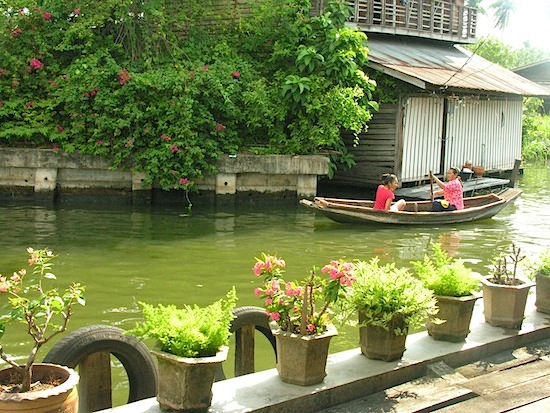
Just rowing along...
You might finish up with an evening at 1001 Nights Gallery to get a feel for Bangkok's underground poetry scene. For dinner, an excellent northern Vietnamese restaurant is nearby, or you could head to Talaat Phlu to get your fill of street food, including some of the city's best (and stinkiest) sticky rice with durian. If that's not enough to satisfy your inner foodie, Khlong San should do the trick.
Keep in mind that even if you're armed with a GPS and all of the directions provided in the posts linked to here, the best way to approach Thonburi is to allow plenty of time to wander and see how the locals live. Although a few main roads are quite busy, traffic is generally not as heavy and Thonburi offers a bit more breathing room than in central Bangkok, though tuk tuks and taxis are readily available if you need them.
A handful of companies offer walking and boat tours of Thonburi, but if the Portuguese could find their way around almost 500 years ago, what's stopping you today?